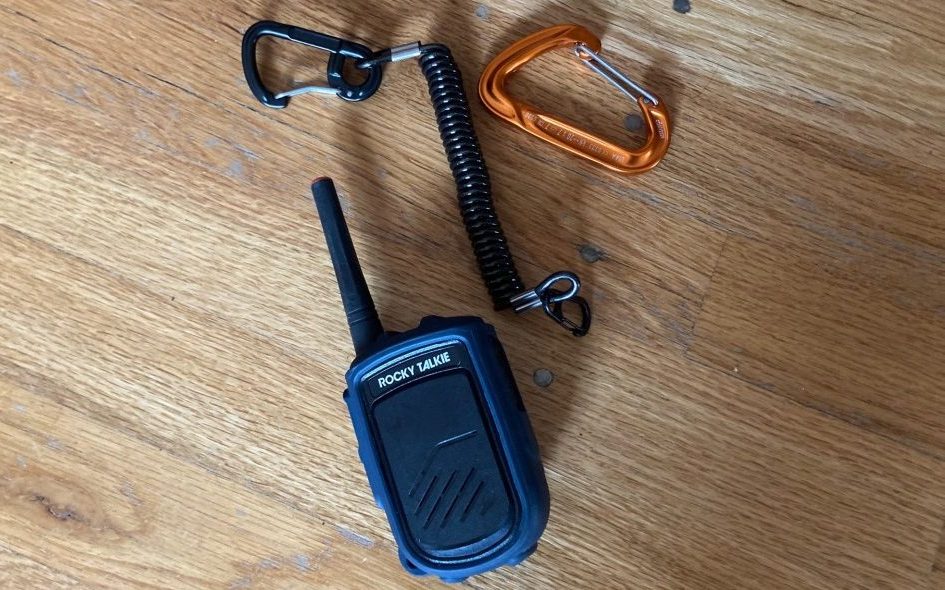
A Rocky Talkie Unit with the Mammut carabiner and backup leash disconnected.
In late October, we got our hands on a set of Rocky Talkie radios. The first look checked out the specs, basic features, and notes about the build and functionality. The Rocky Talkie units get a solid “thumbs up” for those who want to cut to the chase with an emoji-based review.
Otherwise, I’ll start this deeper dive with questions I had about the Rocky Talkie, which retails for $95.00.
Will the Rocky Talkie flop about when skiing?
Short answer: no. The image I posted in the first look shows the radio clipped to the shoulder strap( via the hydration guide) using the robust Mammut carabiner. The backup leash connects to the opposite shoulder strap. This, as noted, remains a no-bounce solution to attach the radio. But, this solution also creates a mild hassle when taking off my backpack; I have to unclip the backup leash. A minor annoyance, but a nuisance. A quick adjustment on-the-fly re-clip and adjustment remedies that.
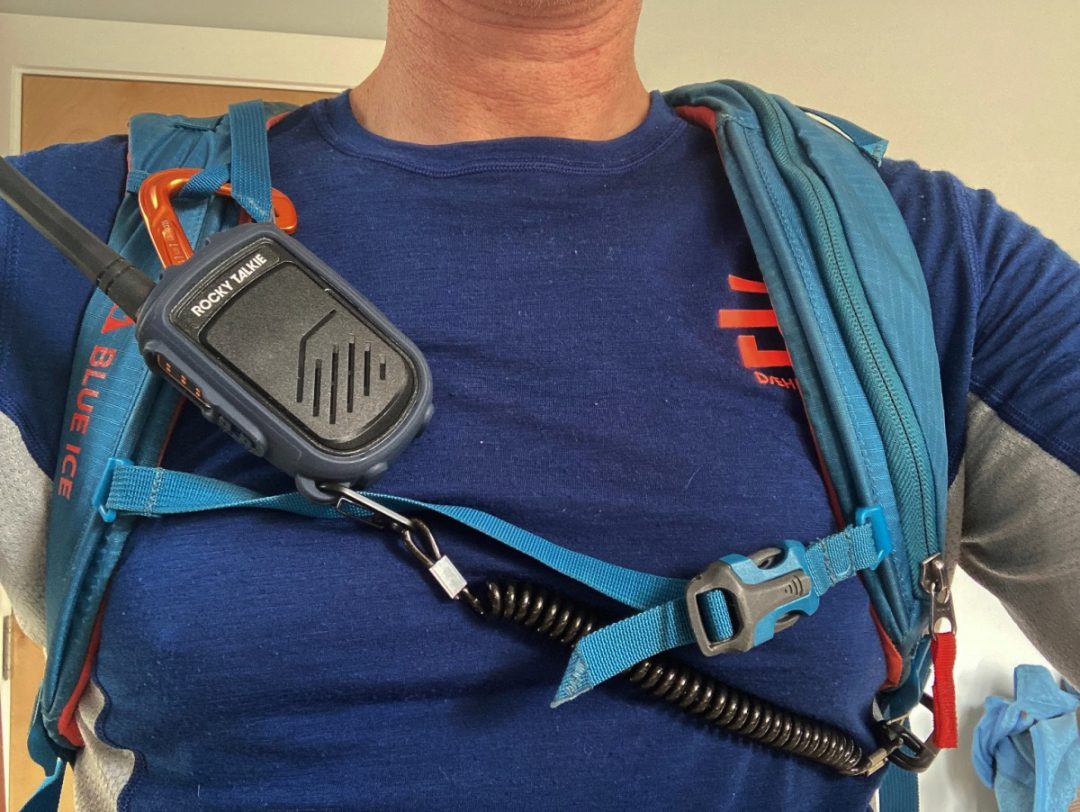
With the radio secured via the orange carabiner and the backup leash clipped to the opposite shoulder strap, no radio flop. But the diagonal backup leash hung up when removing the pack: This was the wrong way for me to fasten the radio.
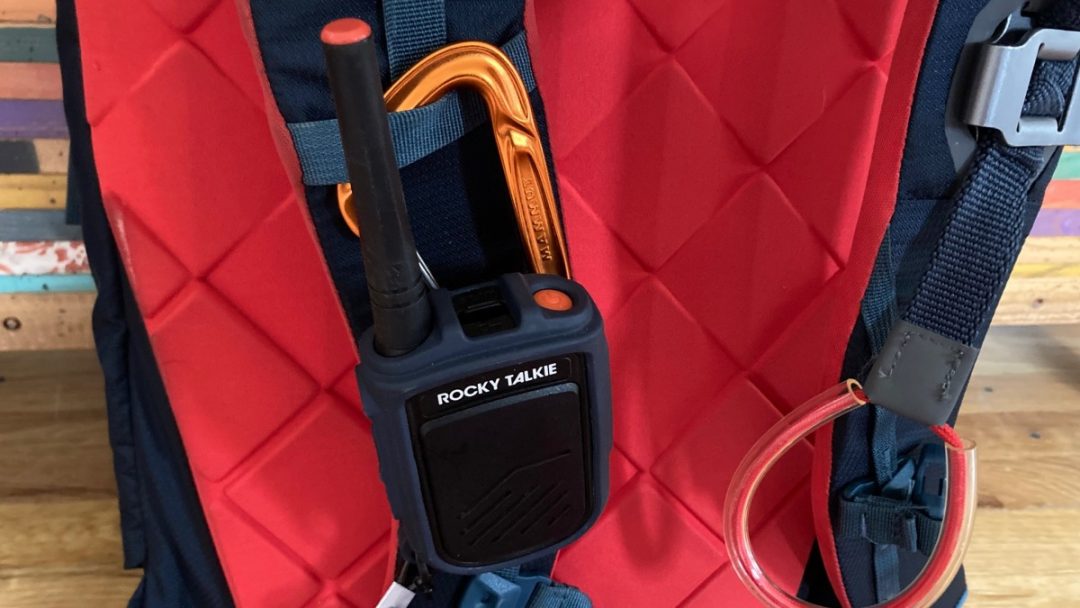
My go to position for the Rocky Talkie: clipping the main carabiner to a fixed horizontal piece of webbing on the left shoulder strap.
All the packs I’ve been using this season, Blue Ice Kume 38L/30L, Mammut Pro X 35L avy pack, and the Gregory Targhee FastTrack 24L feature a sewn gear loop on one side of the waist belt. I clip the main Rocky Talkie carabiner to the upper shoulder strap, and the backup leash to the gear loop. The coiled leash, with mild tension, runs like a plum line straight from the shoulder strap to the gear loop. Configured this way, the Rocky Talkie does not bounce, and I can take my pack off without unclipping the radio’s backup leash. Several times, to test, I clipped the main Rocky Talkie carabiner and not the backup leash: still, no discernible bounce when skiing.
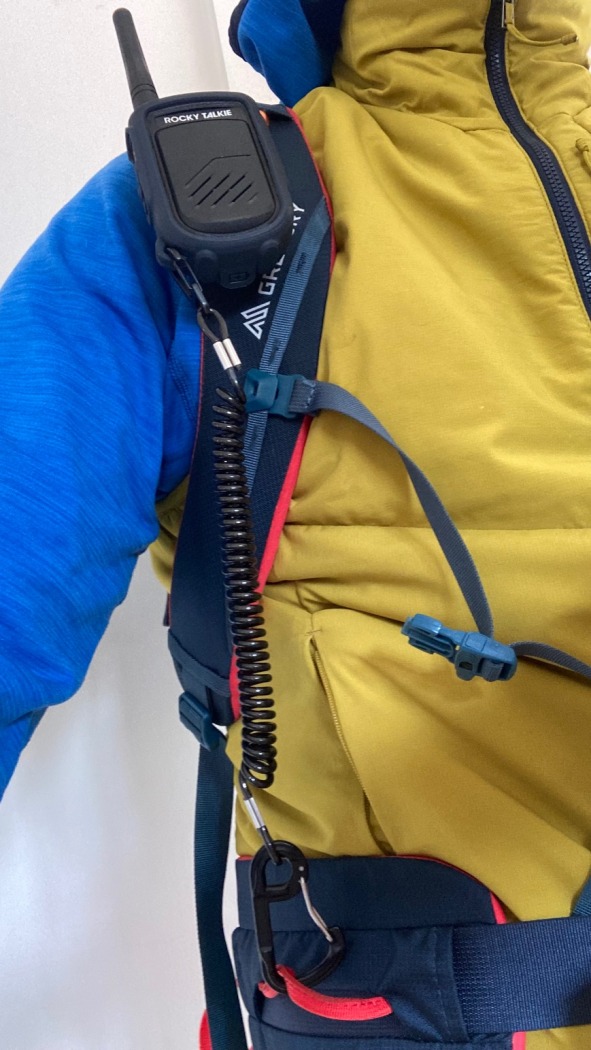
The Rocky Talkie is clipped to the left shoulder strap while the backup leash is clipped to the gear loop on the left side of the waist belt. This is an effective way to connect the radio.
Battery Life
The radios come stock with a replaceable lithium-ion battery that is recharged via a USB-C port. Spare batteries sell for $22.00. The only instances I did not carry the Rockie Talkie this season were uphilling at the resort or touring on groomed snow-mobile trails outside town. Otherwise, even if out for a solo tour, the radio came along and was turned on. Even on days where radio transmissions were frequent because my partners and I would communicate several times each run to relay skier-position, the batteries were robust. On a cold day, 10-15°F range, I saw the charge drop from near 100% to 82%. Well within the acceptable range for me. I have also gone a few weeks with no recharge on the radio. I have not purchased a spare battery, so without the option to swap a battery in the field, I do check the % charge before each usage. On a heavy use week for me, the radio was out and used on four successive backcountry ski days; I let the charge fall into the 60% range before the recharge.
The recharge took under three hours to bump from the mid-60% zone to fully charged.
So far, the battery functions well—meaning it holds a charge and recharges easily. Rocky Talkie states one can expect longer battery life operating the radio in low power mode (0.5 Watts) as compared to high power mode (2 Watts). I keep the radio on a high power channel and have not defaulted to lower power mode.
Radio Compatibility
As a newish company, Rocky Talkies are not ubiquitous. I’m more often than not skiing with partners using the BCA Link 1 or Link 2 radios. I have skied with two partners using Rocky Talkies. Without diving into the nuances of channel selection, I covered that a bit in the first look, here’s what I wrote:
“For compatibility between BCAs and Rocky Talkies, you must use channels 1-22. Once you have selected a channel, add a privacy code, the 121 privacy codes are standard between the two brands. After completing that two-step process, you have a sure-fire way to allow inter-brand radio communication.”
Inter-communication between the two brands was a non-issue. (Use channels 1-22 for the synch, then set a privacy code.) We also select channels and test before leaving the parking lot. It’s become something like a beacon check; we check to ensure everyone is on the same channel and do the radios transmit and receive.
I was able to connect with our older Motorola T-600 radio as well. However, I took the T-600 out once since receiving the Rocky Talkie. It’s the backup at this point.
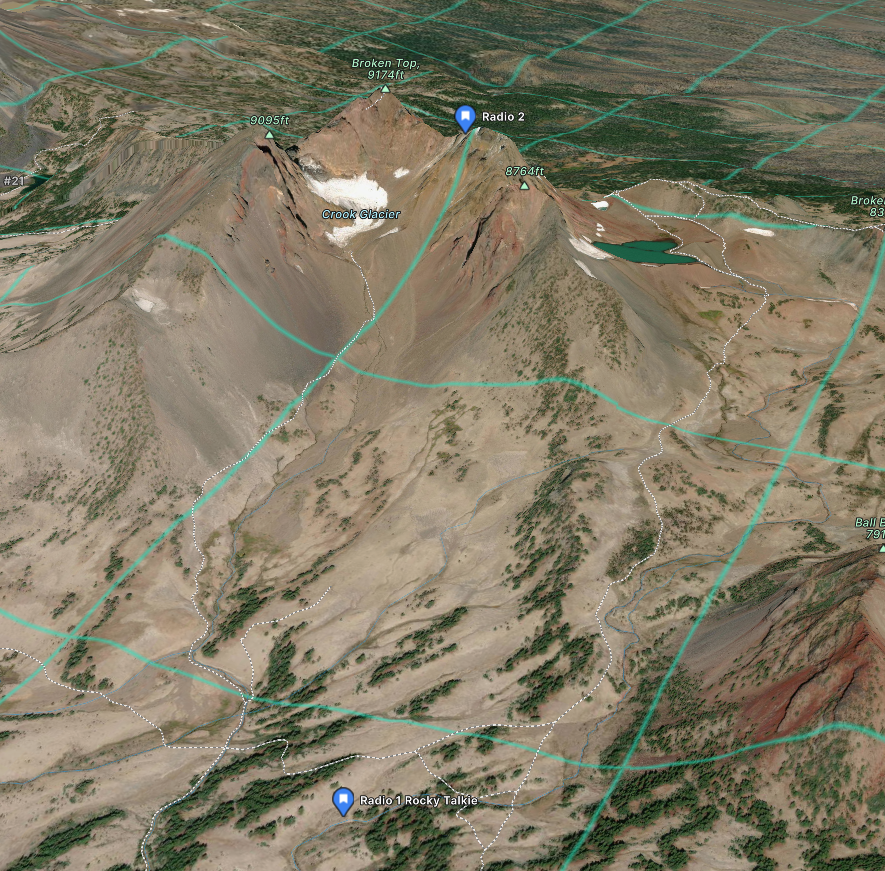
A map image showing the functional range of the Rocky Talkie used with a BCA Link 2. The Rocky Talkie was positioned at the bottom of a large crater/cirque and roughly 8000+ feet (walking distance) separated the radios. There was not a clean line of sight. Radio 2 was positioned behind a ridge.
Radio Range
What I’ll discuss here are the situations we encountered while backcountry skiing. And for what it is worth, as it is a company video, Rocky Talkie does provide an informative video detailing their findings regarding radio range functionality.
My usual group of ski partners has a tacit understanding that we ideally want eyes on a skier when one of us is descending. The protocol calls for the descending skier to transmit via the radio an “I’m in a good spot” when they’ve concluded their turns. Before dropping, the next skier to descend does a quick radio check with the partner below. It’s a simple process to ensure we know the basics of the who, when, and where.
I never had the Rocky Talkie fail to connect with another skier in my group. In most instances, we were descending at 500-1000 foot increments in either thinly forested or alpine terrain. The Rocky Talkies could transmit and receive well during the alpine outings, even when communicating with another skier approximately 1500 feet below and tucked behind a large cliff band. In this instance, several tall rock pinnacles also blocked a clean line of sight.
On a clear day, as I was approaching the vast open bowl/crater of Broken Top, (see photo above), I could communicate with a group of skiers already making their way to an alpine ridge a mile distant. Again, I had no problems transmitting or receiving using the Rocky Talkie (I spoke with a skier using a BCA Link 2).
On another occasion, when the terrain became crampon/axe worthy, we chose to ascend one at a time to avoid climbing on top of one another. As a simple device to check when the ascending skier was in a safe spot or to determine if the couloir above was skiable (it was not for me, but was likely so for bolder folks), the luxury of radio comms is great. There’s no screaming over the wind to communicate.
The point is this: the Rocky Talkie worked great in a situation where my partner had gone up several hundred feet, had snaked in and around a ridge, and was way out of sight.
The info in this section is qualified with the caveat that I was not testing the range of the Rocky Talkie on a scale of miles and miles or Ks and Ks.
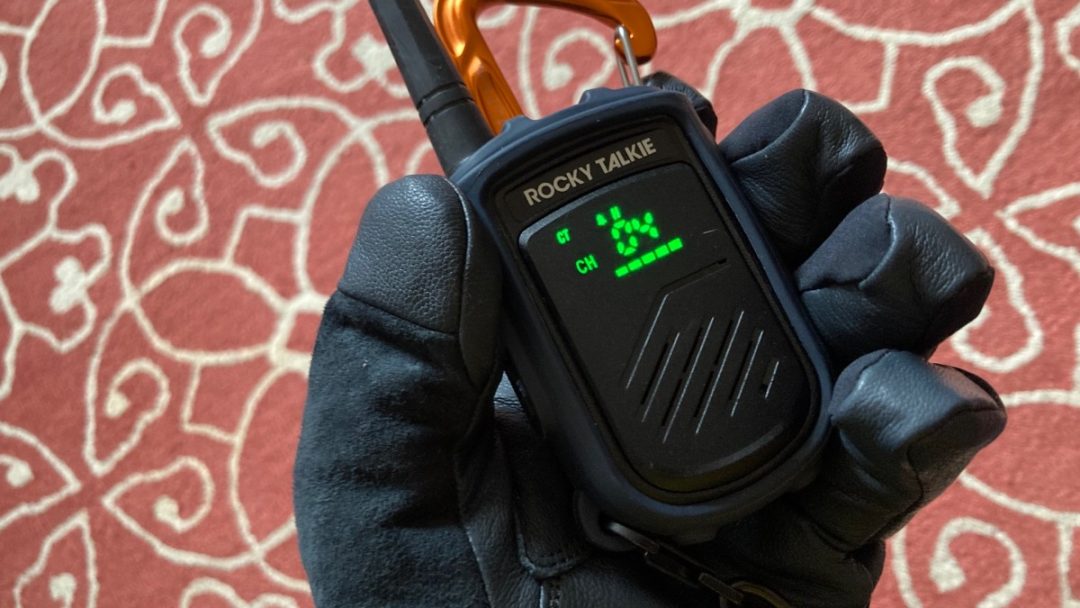
The Rocky Talkie is easily handled and the transmission button is easily triggered wearing warm gloves. These are BD Enforcer gloves.
Likes
I’m aware we do a lot of reviewing on WildSnow. And I’m aware that all this amounts to reviewing gear that will cost folks money if you choose to lay down the cash. For me, I’d gladly pay the $95 for another unit to get one of my family members into one of these. I found the channel setting and code assigning intuitive. Although this may seem superficial, a prized function is also the lock switch. On one occasion, I could not communicate with a partner using a BCA radio since their channel had switched unintentionally: With the Rocky Talkie, I can lock the channel and call it good.
The build of the Rocky Talkie so far is bomber. I’ve had no issues with moisture penetrating the unit or adversely impacting it. The rubberized case has protected the unit from falls when I’ve dropped it in the house. And the easy-to-read shatter-proof screen is no-nonsense.
The scan mode works as designed. However, triggering any button during the radio’s scan causes the unit to cease scanning. Yet with the ease of swapping channels and setting a code on the Rocky Talkie, I always check 4-20 (go figure) as a first option to determine if any other skiers are in the same zone. Mostly without fail, there’s some good banter on that channel.
I love most that the Rocky Talkie is a relatively simple to use communication tool.
Possible-Future Mods
I know some like the two-piece BCA Radio’s design. They appear more minimalist on the outside of a pack: all you see is the mic. The Rocky Talkies can accept an aftermarket mic/headset with a “2-pin port (K1 type connector) with a 3.5mm pin and a 2.5mm pin.” I’ve not tested this, but I know some dedicated BCA radio users love the separate mic and the ability to stash the radio unit in the pack or in a warm spot on their body to prevent a loss of battery charge. I’m sure when I have my inReach dangling off my backpack and the Rocky Talkie front and center, I look like I’m all set for anything but partaking in soul sport.
The Rocky Talkie currently does not connect to NOAA weather channels. And I carry an inReach Mini for emergencies, the Rocky Talkie is not meant to communicate with emergency/SAR channels.
Rocky Talkie or not, my radio handle is Bo-Peep.
Jason Albert comes to WildSnow from Bend, Oregon. After growing up on the East Coast, he migrated from Montana to Colorado and settled in Oregon. Simple pleasures are quiet and long days touring. His gray hair might stem from his first Grand Traverse in 2000 when rented leather boots and 210cm skis were not the speed weapons he had hoped for. Jason survived the transition from free-heel kool-aid drinker to faster and lighter (think AT), and safer, are better.
